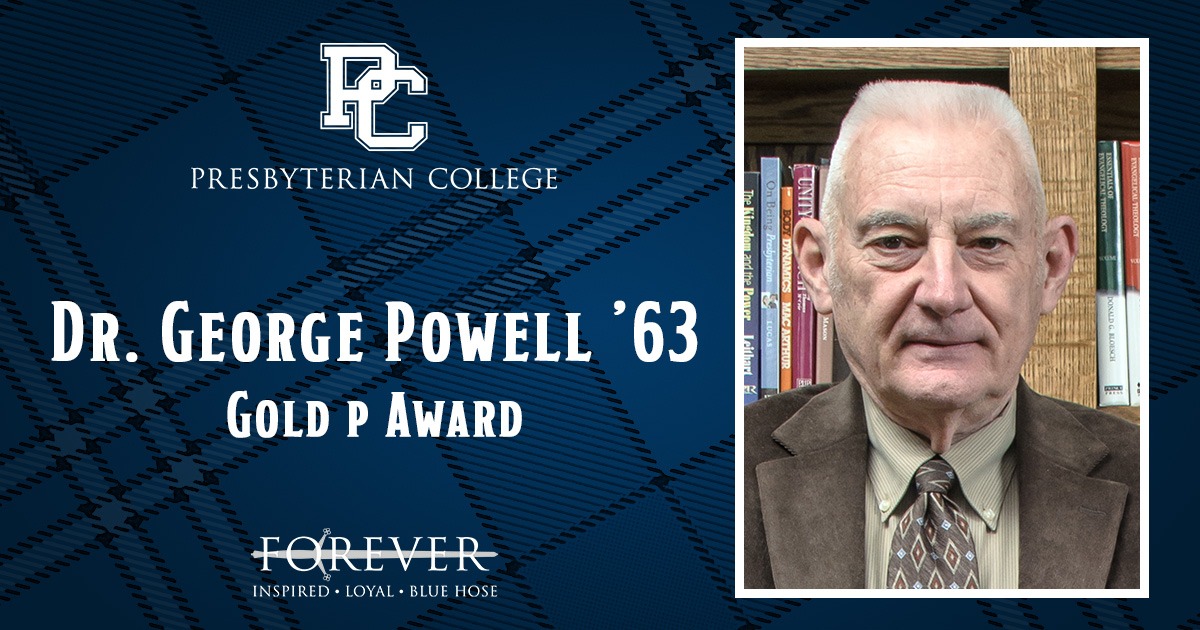Dr. George Louis Powell ’63 receives Gold P Award

Dr. George Louis Powell became a distinguished scientist, inventor and technologist after graduating from PC in 1963.
Because of his accomplishments, he has been named the 2020 Gold P Award recipient. The honor recognizes an alumnus or alumna for outstanding accomplishments in the chosen profession, which reflect honor upon the College.
Powell grew up in the small town of Wallace, NC, strongly influenced by his environment that included family that were subsistence farmers recovering from the depression, parents that were obsessed with sending their children to college, and Rev. W. B. Hood, our minister, who directed Powell to PC.
After graduating cum laude from PC with a chemistry degree, Powell went on to marry Sylvia Chestnutt in 1964, and earn a Ph.D. in chemistry (1967) from the University of North Carolina, Chapel Hill. He has been actively employed on the development staff at the Y-12 National Nuclear Security Complex, CNS Y-12, in Oak Ridge, Tenn., since 1967. More recently Y-12 was incorporated into the Manhattan Project National Historical Park since its original uranium isotope separation instrumentation is included in a museum tour.
“As a kid growing up in Oak Ridge, we never discussed the nature of the work going on at any of the three plant locations (X-10, Y-12 and K-25),” said Powell’s daughter, Dr. Kimberly Powell Crapse. “It was sufficient to say, ‘My dad works at the plant.'”
A physical chemist, Powell’s main interests are kinetic spectroscopy, infrared spectroscopy surface and gas analysis, thermodynamics, transport phenomena, and isotope effects in metal-hydrogen systems, surface analysis, imaging, and inspection, corrosion and hydrogen embrittlement, particularly as these phenomena relate to uranium and its alloys, palladium and its alloys, lithium and lithium hydride, hydrogen storage, and hydrogen getters.
Powell’s thesis research involved the nanosecond to millisecond kinetics measurements of fluorescence lifetimes and other excited state processes in visible and ultraviolet spectroscopy. At Y-12, he pioneered the application of auger spectroscopy and low-energy-electron diffraction to the study of metal hydride surfaces and discovered the auger line for lithium metal.
Powell led in the development of the physical and analytical chemical, as well as metallurgical methods, for controlling internal hydrogen in uranium alloys. He is an authority on the metallurgical processing of uranium alloys to achieve high ductility and on the corrosion of uranium and its alloys by environmental gases and hydrogen.
Collaborative research with the KFA Research Center in Julich, Germany, has led to a thorough experimental and theoretical description of the solubility, thermodynamic properties, diffusion, and surface properties of hydrogen isotopes, including tritium, in palladium and its alloys; and demonstrated that, for pressure-volume-temperature measurements, these capabilities are at least comparable to the best that have been published.
Powell was instrumental in the establishment of a Fourier transform infrared spectroscopy capability at Y-12. In collaboration with Harrick Scientific, Inc., Powell led in the development of evacuable cells (IR-100 Award, 1984) and remote sensing (R&D-100 Award, 1989) FTIR accessories.
Recent advances in this area include the development of portable FTIR spectroscopy, in collaboration with Surface Optics Corporation, for the analysis of the surfaces of large objects with the results displayed in the form of images reduced from laboratory quality infrared spectra. He implemented DRIFT (diffuse reflectance infrared Fourier transform) inspection as a process control device, and has kept it operational in Y-12 for 23 years.
“Dr. Powell is one of the leading specialists in the field of critical cleaning,” said Dr. Martin Szczesniak, with Surface Optics Corporation. “His expertise is recognized and sought after by organizations such as NASA, Boeing, Los Alamos National Laboratory, and Sandia National Laboratory.
“I value and recognize his outstanding accomplishments in diverse fields, but even more I value his moral character and the depth of his personality.”
Powell participated in the Network of Senior Scientists and Engineers from 2000 to 2014, leading the gas sampling and analysis promotion that led eventually to a permanent solution to the high-resolution mass-spectrometer maintenance dilemma. He has over 100 publications in the open literature including four book chapters on Hydrogen in Uranium and Uranium corrosion.
He regularly participates in the Hydrogen-Metals Gordon Research Conferences; the Metal-Hydrogen Systems-Fundamentals and Applications Conferences; the International Conference on the Effects of Hydrogen on Materials; the International Conference on Advanced Vibrational Spectroscopy; the Pittsburgh Conference on Applied Spectroscopy and Analytical Chemistry; JOWOG 28 Main Meetings and Focused Exchanges; NNSA Compatibility, Aging, and Stockpile Stewardship Meetings; and the NNSA Gas Technology Meetings.
“Dr. Powell became an expert … over the years of his graduate studies and accomplished many years of dedicated work,” Szczesniak said.
“However, it was your college that helped him to develop the spirit of hard work grounded in Christian values. Your college developed his inquisitive mind and propelled him on the quest of a great life bursting with adventure in science and technology.”
